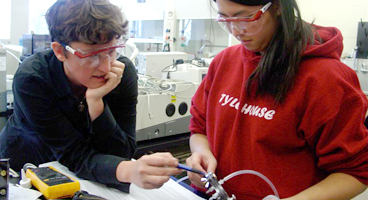Document Type
Article
Publication Date
2-1-2006
Publication Title
Otology and Neurotology
Abstract
Background: Although tympanic membrane perforations are common, there have been few systematic studies of the structural features determining the magnitude of the resulting conductive hearing loss. Our recent experimental and modeling studies predicted that the conductive hearing loss will increase with increasing perforation size, be independent of perforation location (contrary to popular otologic belief), and increase with decreasing size of the middle-ear and mastoid air space (an idea new to otology).
Objective: To test our predictions regarding determinants of conductive hearing loss in tympanic membrane perforations against clinical data gathered from patients.
Study Design: Prospective clinical study. Setting: Tertiary referral center.
Inclusion Criteria: Patients with tympanic membrane perforations without other middle-ear disease. Main Outcome Measures: Size and location of perforation; air-bone gap at 250, 500, 1,000, 2,000, and 4,000 Hz; and tympanometric estimate of volume of the middle-ear air spaces.
Results: Isolated tympanic membrane perforations in 62 ears from 56 patients met inclusion criteria. Air-bone gaps were largest at the lower frequencies and decreased as frequency increased. Air-bone gaps increased with perforation size at each frequency. Ears with small middle-ear volumes, ≤4.3 ml (n = 23), had significantly larger air-bone gaps than ears with large middle-ear volumes, >4.3 ml (n = 39), except at 2,000 Hz. The mean air-bone gaps in ears with small volumes were 10 to 20 dB larger than in ears with large volumes. Perforations in anterior versus posterior quadrants showed no significant differences in air-bone gaps at any frequency, although anterior perforations had, on average, air-bone gaps that were smaller by 1 to 8 dB at lower frequencies.
Conclusion: The conductive hearing loss resulting from a tympanic membrane perforation is frequency-dependent, with the largest losses occurring at the lowest sound frequencies; increases as size of the perforation increases; varies inversely with volume of the middle-ear and mastoid air space (losses are larger in ears with small volumes); and does not vary appreciably with location of the perforation. Effects of location, if any, are small.
Keywords
Audiometry, Conductive hearing loss, Perforation, Tympanic membrane, Tympanometry
Volume
27
Issue
2
First Page
136
Last Page
143
DOI
10.1097/01.mao.0000176177.17636.53
ISSN
15317129
Recommended Citation
Mehta, Ritvik P.; Rosowski, John J.; Voss, Susan E.; O'Neil, Ellen; and Merchant, Saumil N., "Determinants of Hearing Loss in Perforations of the Tympanic Membrane" (2006). Engineering: Faculty Publications, Smith College, Northampton, MA.
https://scholarworks.smith.edu/egr_facpubs/72



Comments
Peer reviewed accepted manuscript.